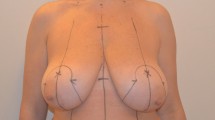Abstract
Background
Mastopexy autoaugmentation by using an extended vertical flap and two transverse triangular flaps of mammary parenchyma was performed through an adjustable vertical ice cream cone-shaped approach.
Method
A vertical rectangular flap with the length of the inferior pole and thickness of the mammary parenchyma was supported at the inframammary fold. Dissection of the vertical flap was extended underneath the areola until the projection of its upper limit, adding 4–5 cm to the length of the vertical flap. A triangular flap supported on its lower half with 4–6 cm long and thickness of the vertical pillar was dissected on both vertical pillars. Patients were followed up for 2 years.
Results
The vertical rectangular flap filled the upper pole and central breast. The triangular flaps apart from filling the lower pole increased the mammary cone projection. The medial rotation advancement of the triangular flaps created a transverse support girdle at the lower pole, maintaining the vertical flap into position. In addition, fixation of the vertical flap along its entire length avoided long-term down-displacement of the breast. A keel resection of mammary parenchyma was performed in the larger breast in mild or moderate asymmetries.
Conclusion
Mastopexy autoaugmentation through an adjustable vertical approach using vertical and triangular flaps of mammary parenchyma filled the upper pole and central breast and reshape the lower pole, recovering the breast contour. It provided long-term stabilization of the mammary cone without a breast implant or fat transfer.
Level of Evidence IV
This journal requires that authors assign a level of evidence to each article. For a full description of these evidence-based medicine ratings, please refer to the Table of Contents or the online Instructions to Authors www.springer.com/00266.











Similar content being viewed by others
References
Henderson PW, Nash D, Laskowski M, Grant RT (2015) Objective comparison of commercially available breast implant devices. Aesth Plast Surg 39(5):724–732
Wan D, Rohrich RJ (2016) Revisiting the management of capsular contracture in breast augmentation: a systematic review. Plast Reconstr Surg. 137(3):826–841
Brody GS, Deapen D, Taylor CR, Pinter-Brown L, House-Lightner SR, Andersen JS, Carlson G, Lechner MG, Epstein AL (2015) Anaplastic large cell lymphoma occurring in women with breast implants: analysis of 173 cases. Plast Reconstr Surg 135(3):695–705
Fuchs S, Lisabeth-Broné K, Vriens-Nieuwenhuis EJC, van der Sluis WB (2017) Surgical outcome and cosmetic results of autologous fat grafting after breast conserving surgery and radiotherapy for breast cancer: a retrospective cohort study of 222 fat grafting sessions in 109 patients. Aesth Plast Surg 41(6):1334–1341
Kontoes P, Gounnaris G (2017) Complications of fat transfer for breast augmentation. Aesth Plast Surg 41(5):1078–1082
Ors S (2016) Autoaugmentation mastopexy modification prevents bottoming-out deformity and areola distortion: a preliminary report. Aesth Plast Surg 40(4):497–506
Kirwan L, Wazir U, Mokbel K (2015) Breast auto-augmentation: a versatile method of breast rehabilitation—a retrospective series of 107 procedures. Arch Plast Surg 42(4):438–445
Abramo AC, Teixeira JC, Galindo A (2004) Mammaplasty combining vertical and transverse approaches through a vertical incision. Plast Reconstr Surg 113(2):508–516
Abramo AC (2018) Arie’s technique: surgical principles and its historical importance for mastoplasty. In: Avelar J (ed) Breast surgery: aesthetic approaches, 1st edn. Springer, Cham, pp 227–235
Beer GM, Morgenthaler W, Spicher I, Meyer VE (2002) Modifications in vertical scar breast reduction. Br J Plast Surg 54:341–347
Nahai F (2005) Superior pedicle vertical scar mammaplasty: surgical technique. In: Hamdi M, Hammond DC, Nahai F (eds) vertical scar mammaplasty. Springer, Berlin, pp 25–35
Spear SL, Howard MA (2003) Evolution of the vertical reduction mammaplasty. Plast Reconstr Surg 112:855–868
Cohen R (2018) Mastopexy options and techniques. Vol. 5 breast. Section 1 aesthetic breast surgery. In: Nelegan PC, Nalbedian MY (eds) Plastic surgery, 4th edn. Elsevier Inc., Amsterdam, pp 87–107
Ribeiro L, Accorsi A Jr, Buss A, Marçal-Pessoa M (2002) Creation and evolution of 30 years of the inferior pedicle in reduction mammaplasties. Plast Reconstr Surg 110:960–970
Hönig JF, Frey HP, Hasse FM, Hasselberg J (2010) Inferior pedicle autoaugmentation mastopexy after breast implant removal. Aesth Plast Surg 34(4):447–454
Graf R, Biggs TM (2002) In search of better shape in mastopexy and reduction mammaplasty. Plast Reconstr Surg 110(1):309–317
Abramo AC (2018) Vertical mammaplasty: vertical and transverse flaps through a vertical incision. In: Avelar J (ed) Breast surgery, 1st edn. Springer, Cham, pp 371–375
Wong C, Vucovich M, Rohrich R (2014) Mastopexy and reduction mammoplasty pedicles and skin resection patterns. Plast Reconstr Surg Glob Open 2(8):e202
Abramo AC (1991) Pattern for reduction mammaplasty that uses a vertical dermal pedicle. Aesth Plast Surg 15:265–270
Author information
Authors and Affiliations
Corresponding author
Ethics declarations
Conflict of interest
No financial support or benefits have been received by the author or any co-author to accomplish this manuscript.
Ethical Approval
All procedures performed in this study involving human participants were in accordance with the ethical standards of the ACA - Institute of Assistance in Plastic Surgery of São Paulo research committee and with the 1964 Helsinki Declaration and Medical Research Involving Human Subjects and its later amendments or comparable ethical standards.
Informed Consent
Patients signed an informed consent form agreeing to the proposed treatment.
Additional information
Publisher's Note
Springer Nature remains neutral with regard to jurisdictional claims in published maps and institutional affiliations.
Rights and permissions
About this article
Cite this article
Abramo, A.C., Lucena, T.W., Sgarbi, R.G. et al. Mastopexy Autoaugmentation by Using Vertical and Triangular Flaps of Mammary Parenchyma Through a Vertical Ice Cream Cone-Shaped Approach. Aesth Plast Surg 43, 584–590 (2019). https://doi.org/10.1007/s00266-019-01337-1
Received:
Accepted:
Published:
Issue Date:
DOI: https://doi.org/10.1007/s00266-019-01337-1




